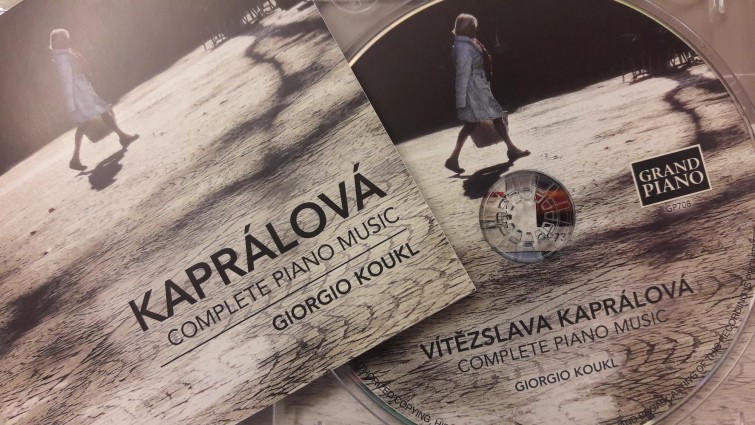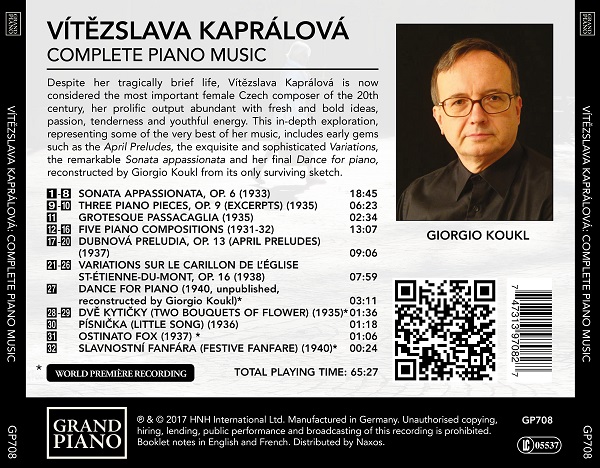
Grand Piano (Naxos Records) GP708 CD (February 2017). A Diapason d'or disc (May 2017). Available from amazon.com and other outlets.
Performed by Giorgio Koukl (piano).
Producer: Giorgio Koukl
Recording Director: Michael Rast
Sound Engineers: Dag Helseth, Michael Rast
Booklet Editor: Peter Bromley
Design Manager: Armand Alcazar
Liner notes: Karla Hartl
French translation: David Ylla-Somers
Cover art: Tony Price
Recorded on January 5 and March 25, 2016, at Conservatorio Lugano, Switzerland.
From reviews:
Kapralova’s expression is uniquely her own, original, vivacious and captivating.
Norman Lebrecht
A fabulous, thoroughly enjoyable and fascinating disc of truly inspirational music.
Steve Arloff
A great introduction to a composer who definitely deserves to be better known.
Lynn René Bayley
and more...
The pianist/harpsichordist and composer Giorgio Koukl (1953) was born in Prague where he studied at the Prague Conservatory. He continued his music education at the conservatories of Zurich and Milan, where he participated in masterclasses of Nikita Magalov, Jacques Fevrier, Stanislaus Neuhaus, and, most importantly, of Rudolf Firkusny, a friend and advocate of Czech composer Bohuslav Martinu. It was through Firkusny that Koukl first encountered Martinu’s music, which prompted him to search out his solo piano works which since then have become a permanent part of his concert repertoire. Koukl is considered one of the world's leading interpreters of Martinu’s piano music, having recorded Martinu's complete output for solo piano, together with four discs of the composer's vocal music and two discs of his piano concertos. As a logical continuation of this work, Koukl has recorded the complete solo piano works of Paul Le Flem, a Breton composer who belonged to the Parisian circle or composers, which included Martinu, Tcherepnin and Tansman; solo piano works of Arthur Lourie, an important member of the “silver age” group of Russian composers; and the complete solo piano output of Vitezslava Kapralova, Martinu's student and protege.

Please note that all of the music recorded on this disc is in print. Click here for the complete discography of Kapralova's music.
Like her composer father, Kapralova was drawn to piano as her natural instrument, and piano compositions are well represented in her relatively large creative output that includes about fifty compositions. Piano also played a crucial role in her music as a compositional tool with which she experimented in both smaller and larger forms. It is therefore not surprising that her most original and sophisticated works are for this instrument: from her Sonata Appassionata and Piano Concerto in D Minor to April Preludes and Variations sur le carillon de l’eglise St.-Etienne du Mont (and the Martinu– influenced, neoclassical Partita in which piano also plays an important percussive role). Piano compositions arguably represent the best of Kapralova’s music which abounds in fresh and bold ideas, humour, passion and tenderness, and is imbued with youthful energy.
This release is an in-depth exploration of Kapralova’s development as a composer for piano. The first composition to appear on the disc is the remarkable two-movement Sonata Appassionata, op. 6, from 1933, which is considered a major contribution to twentieth century Czech sonata literature. The first movement in traditional sonata form radiates passionate intensity; the second movement is a theme and set of lyrical variations which gradually obscure the melodic and harmonic connections to the theme. The sonata is followed by three bold, contemporaneous exercises in originally Baroque forms: “Praeludium” and “Crab Canon” (from Three Piano Pieces, op. 9) and Grotesque Passacaglia. These pieces, all from 1935, are products of the composer’s studies at the Prague Conservatory, as is the pianistic gem April Preludes, op. 13, from 1937, four brief and highly varied pieces that represent a major stepping stone in Kapralova’s development as a composer and remain her most often performed and recorded work for solo piano. They are preceded by the earliest work on this disc - Five Piano Compositions, from 1931–1932. Kapralova was only sixteen and seventeen when she composed the pieces but their emotional maturity and pianistic demands set them apart from her earlier juvenilia. Kapralova coined the title Piano Suite for the first four of them and valued them enough to orchestrate them three years later under the title Suite en miniature, op. 1. The fifth composition, with tempo indication Alla marcia funebre, later became her Funeral March, op. 2. The Variations sur le carillon de l’eglise Saint-etienne–du-Mont, op. 16 were composed in Paris in 1938. These variations on a theme, a form Kapralova favoured, are an exquisite example of the composer’s sophisticated musical vocabulary with its highly original harmonies, already firmly established in April Preludes. Kapralova subjected the theme to six variations as in the second movement of her sonata; here, however, the theme, based on a repetitive melodic pattern of the peal of bells from a Parisian church, is extremely brief and simple. The work was so admired by Bohuslav Martinu that he helped to have it published by La Sirène editions musicales in Paris the same year. The survey of Kapralova’s piano catalogue continues with her last work for piano solo - Dance for Piano (1939-1940), reconstructed for this recording by Giorgio Koukl from the only surviving sketch of the composition which was originally conceived as Two Dances for Piano, op. 23. The work was commissioned by one of Kapralova’s most notable interpreters, virtuoso pianist Rudolf Firkusny, but the second dance was likely never finished and our sketch remains the only expression of the entire composition. While we cannot be certain whether this is what the final composition would have looked like, as Kapralova was known to revise her sketches, the reconstructed score successfully captures the spirit of the piece. Our exploration of a remarkable musical voice of the twentieth century ends with five piano miniatures. Two Bouquets of Flowers, from 1935, are miniature musical poems, two melancholic reminiscences - the first entitled “Small Bouquet of Violets,” the second “Autumn Leaves.” Little Song, from 1936, is the composer’s only contribution to children’s piano literature. Ostinato Fox (1937) and Festive Fanfare (1940) were both intended as musical presents: Kapralova composed the first for her friend Jirinka Cernusakova, the daughter of Gracian Cernusak, an esteemed Brno musicologist, and the second as a birthday present to Sasenka Pucova, the twelve-year-old daughter of Cestmir Puc, one of Kapralova’s benefactors in Paris.
All of the piano pieces featured on this disc are available in print: a few were published during Kapralova’s lifetime (Grotesque Passacaglia, Little Song, April Preludes, and Variations sur le carillon), the others following the Kapralova revival in the first decade of this millennium. Some of this music has also been released on record; however, this release presents the most complete collection of Kapralova’s works for piano solo recorded to date, and features four world premieres: Two Bouquets of Flowers, Ostinato Fox, Festive Fanfare, and, most importantly, Dance for Piano.
Karla Hartl
Sample this CD recording